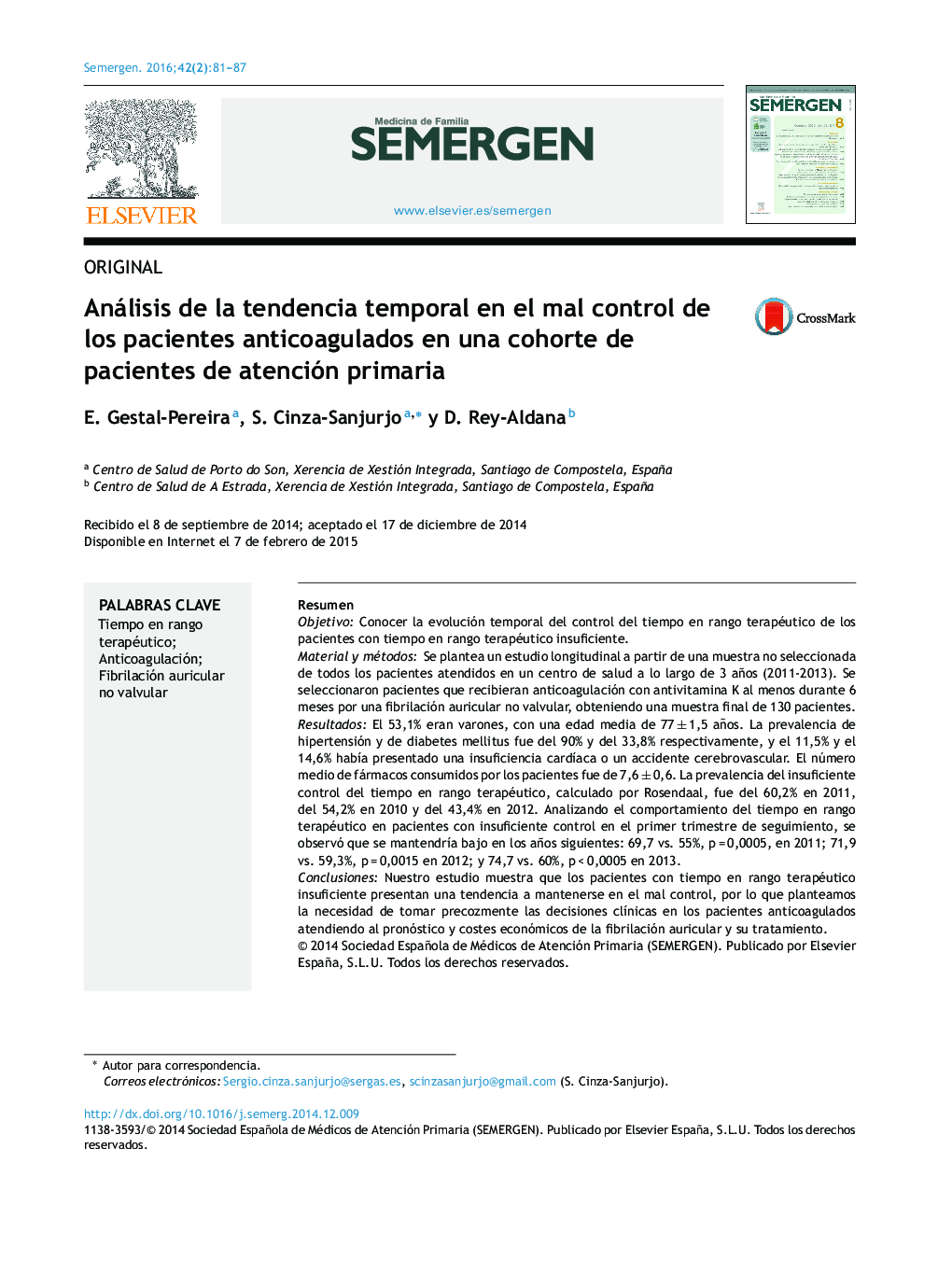| Article ID | Journal | Published Year | Pages | File Type |
|---|---|---|---|---|
| 3834501 | SEMERGEN - Medicina de Familia | 2016 | 7 Pages |
ResumenObjetivoConocer la evolución temporal del control del tiempo en rango terapéutico de los pacientes con tiempo en rango terapéutico insuficiente.Material y métodosSe plantea un estudio longitudinal a partir de una muestra no seleccionada de todos los pacientes atendidos en un centro de salud a lo largo de 3 años (2011-2013). Se seleccionaron pacientes que recibieran anticoagulación con antivitamina K al menos durante 6 meses por una fibrilación auricular no valvular, obteniendo una muestra final de 130 pacientes.ResultadosEl 53,1% eran varones, con una edad media de 77 ± 1,5 años. La prevalencia de hipertensión y de diabetes mellitus fue del 90% y del 33,8% respectivamente, y el 11,5% y el 14,6% había presentado una insuficiencia cardíaca o un accidente cerebrovascular. El número medio de fármacos consumidos por los pacientes fue de 7,6 ± 0,6. La prevalencia del insuficiente control del tiempo en rango terapéutico, calculado por Rosendaal, fue del 60,2% en 2011, del 54,2% en 2010 y del 43,4% en 2012. Analizando el comportamiento del tiempo en rango terapéutico en pacientes con insuficiente control en el primer trimestre de seguimiento, se observó que se mantendría bajo en los años siguientes: 69,7 vs. 55%, p = 0,0005, en 2011; 71,9 vs. 59,3%, p = 0,0015 en 2012; y 74,7 vs. 60%, p < 0,0005 en 2013.ConclusionesNuestro estudio muestra que los pacientes con tiempo en rango terapéutico insuficiente presentan una tendencia a mantenerse en el mal control, por lo que planteamos la necesidad de tomar precozmente las decisiones clínicas en los pacientes anticoagulados atendiendo al pronóstico y costes económicos de la fibrilación auricular y su tratamiento.
ObjectiveTo determine the temporal trend in poorly-controlled anticoagulated patients.Material and methodsA longitudinal study was conducted on a non-unselected sample of all patients seen in a health centre over a period of 3 years (2011-2013). Patients who received anti-vitamin K anticoagulation for at least 6 months due to non-valvular atrial fibrillation were selected, obtaining a final sample of 130 patients.ResultsThe mean age of the sample was 77.0 ± 1.5 years and 53.1% were male. The prevalence of hypertension and diabetes mellitus was 90% and 33.8%, respectively, and 11.5% and 14.6% had had heart failure or a stroke, respectively. The mean number of medications taken by patients was 7.6 ± 0.6. The prevalence of insufficient control of time in therapeutic range, calculated by Rosendaal, was 60.2% in 2011, 54.2% in 2010, and 43.4% in 2012. On analysing the time in the therapeutic range in patients with impaired control in the first quarter of follow-up, it was observed to remain low in subsequent years: 69.7% vs 55%, P = .0005, in 2011; 71.9% vs 59.3%, P = .0015 in 2012; and 74.7% vs 60%, P = .0005 in 2013.ConclusionsOur study shows that patients with inadequate time in therapeutic range have a tendency to stay in poor control, suggesting the need for early clinical decisions in patients on anticoagulants, taking into account the prognosis and economic costs of atrial fibrillation and treatment.
